|
 |
|
|
|
|
| Part 5 Lisbon and Suburbs |
|
 |
|
|
On May 14, after sightseeing around the city of Sevilla, we aimed at Portugal.
It was 11:00 am.
Our bus had to drive all the way from Sevilla, south-west of Spain, in
order to get to Lisbon, tha capital of Portugal, the western end of Iberian
Peninsula.
The border between the two countries was not complicated at all. After
customs clearance, we had lunch just at the Portugal side.
And then the bus dropped by at Evora, a historic town, nearly 13:30. More
than three hours had passed virtually because of the 1-hour time difference.
|
|
|
Évora, May 14
Evora is an ancient city surrounded by castle walls in the inland of Portugal.
We looked around the historic area of the World Heritage for nearly 2 hours
and entered the Cathedral.
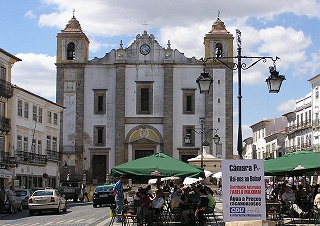 |
| Praça do Giraldo, the center of Evora |
The 16th century was Azuchi-Momoyama Period in Japan.
The 4 young men, as the Tensho embassy, were sent to Europe by the Christian
lord (daimyo) in 1582 (Tensho 10). They met the Pope and the kings of Europe.
They then visited this town in 1584 and were welcomed by the archbishop.
The building of the Society of Jesus where the Tensho embassy stayed for 7 days at that time is now used as a high school.
The contribution of the embassy to their home country Japan was not only
bringing European cultures with them like type printing, European music
instruments and charts. But also they let the culture of Japan be known
in Europe and had the greatest friendship with the European people during
those days.
However, every effort is not necessarily rewarded. Just before they returned
to Japan, the top lord Toyotomi Hideyoshi published the exile order for
Christians.
They seemed to be welcomed back superficially all right, but the fates
of each of them were sad.
I remember Takayama Ukon. He was a Christian daimyo (feudal lord) aloof
from others at that time. He lived from the Warring State Period of Nobunaga
and Hideyoshi to the beginning of Edo Period of Tokugawa Ieyasu. His Christian
name was Justo and he was one of the seven leading disciples of Sen-no-Rikyu,
called Minami-no-bo Tohaku. Rikyu is the historical figure with the most
profound influence on "chanoyu", the Japanese "Way of Tea".
Takayama Ukon is said to have been able to read and write in Portuguese,
and so to have sent his letter to the Pope.
By Hideyoshi's order, he was exiled to Manila, the Philippines, and died
there in 1615 (Keicho 20) at the age of 64.
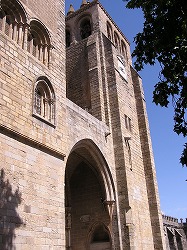 Sé de Évora (Cathedral of Évora) was built in 12th-13th century during
the transitional period from Romanesque to Gothique. Sé de Évora (Cathedral of Évora) was built in 12th-13th century during
the transitional period from Romanesque to Gothique.
The octagonal dome and the solemnly-colored altar were breath-taking.
According to the guidebook, Itoh Mansho and Chijiishi Migeru among the
Tensho embassy played the pipe organ in this cathedral.
The following is the ruins of Temple of Diana of Corinthian Order built
by Romans in the 2nd century. This town is mixed with the Old Ages and
the Middle Ages too.
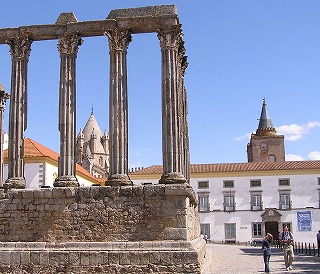
|
|
| Part 5 Lisbon and Suburbs Reading: 5' 49" |
| - - - - - - - - - - - |
| Lisbon (1), May 14-15
After 3:00 pm we left Evora, the historic town, and drove 125 km for 2
hours to Lisbon, facing the Atlantic Ocean.
Leaving our baggage in the hotel we went to the "Melancholy Fado Dinner
Show" in a hurry.
The show started at 9:00 pm and lasted for 2 hours.
On the dark stage, a lady alto on a traditional black dress sings in a plaintive sound accompanied by a flamenco guitar and a guitarra (Portuguese guitar). On another stage, folk dancing by a male and a female.
It was quite enjoyable full of melancholy and all of us forgot to taste
a dinner.
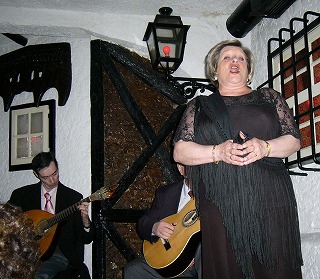
Basking in the afterglow of the Fado show, I went to bed at midnight. A
long long day ended at last.
-----
It is May 15. In the morning we are going to drive 6 km west from the center
of Lisbon along Tejo River to Belém District. There are Torre de Belém,
Padrão dos Descobrimentos and Mosteiro dos Jerónimos there, which are the
important memories in the 15th-century Portuguese politics and in the early
days of the Portuguese Empire under Infante Henrique of Portugal, Duke
of Viseu (Henry the Navigator).
We will have a sightseeing in the city tomorrow (May 16) freely.
Torre de Belém
(Belém Tower)

This stone tower is the World Heritage at the mouth of Tejo River to the
Atlantic Ocean. It was built at the beginning of 16th century as a fortress
watching the ships in and out.
The 3rd floor used to be the rooms of the royal family, the 2nd the gun
battery and the 1st a water jail.
To enter it was permitted but we didn't, missing the grand view of the
Atlantic Ocean from the terrace.
Blessed by the mild weather, the coast surrounding the tower was busy with
fishing people.
Padrão dos Descobrimentos
(Monument to the Discoveries)

|
 This monument, 52 meters high, is made of concrete. It was built as a symbol
of the International Exposition held in Portugal in 1940 at first, and
was reproduced and rebuilt in 1960. This monument, 52 meters high, is made of concrete. It was built as a symbol
of the International Exposition held in Portugal in 1940 at first, and
was reproduced and rebuilt in 1960.
It is located along the river where ships departed to explore and trade
with India and Orient. It celebrates the Portuguese Age of Discovery (or
Age of Exploration) during the 15th and 16th centuries.
In addition to the main statue of Henry the Navigator, holding a model
of a carrack, on either side of the ramps of the monument are a total of
33 figures from the history of the Discoveries.
|
|
Mosteiro dos Jerónimos
(Jerónimos Monastery)
This monastery of the Order of Saint Jerome is located near the shore of
the parish of Belém, and is one of the most prominent examples of the Portuguese
Late Gothique Manueline style of architecture in Lisbon.
It was classified a UNESCO World Heritage Site, along with the nearby Tower
of Belém, in 1983.
It consists of the two buildings, East Side and West Side. We entered and
looked around the East Side.
It was built in the memory of the great achievement of Henry the Navigator
and Vasco da Gama's discovery of India by the sea route in the 15th century.
We looked around Church of Santa Maria. The pillars said to have imitated
palm trees had the trace of the Age of Discovery.
This monastery was as magnificent and solemn as the cathedrals in Spain,
and also looked more luxurious and brilliant. Isn't it because it is not
carrying the Islamic culture?
Getting out to the patio and looking back, the cloister was super to me.
It was the 2-floored arch, 55 meters long. I was fascinated by the elaborate
sculptures.

|
| - - - - - - - - - - - |
|
Cabo de Roca, May 15
After the lunch, viewing the sea at Belém District over the window, we
drove west 45 km for 1 hour. Crossing the top of the pass around Sintra,
Cabo de Roca (Cape of Roca) appeared.
The Roca, a dignified cape located at the westernmost of Iberian Peninsula
which is the tip of the Eurasian Continent, is looking down the Atlantic
Ocean of rough waves.
Standing around Roca Cape, I strangely felt something different. It was
the real view of freshness without anythng related to the insatiable frictions
of religions, dynasties and empires.
This place, blessed by the natural climate, really seemed to be indifferent
to any ugly frictions of human beings.

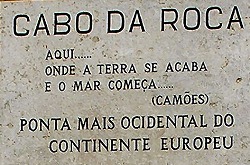 "ONDE A TERRA SE ACABA E O MAR COMEÇA" means "This is the
end of the land and the beginning of the sea". "ONDE A TERRA SE ACABA E O MAR COMEÇA" means "This is the
end of the land and the beginning of the sea".
It is the passage of the poem by Luís Vaz de Camões, a Potuguese poet.
It must have been the tip of the earth with deep emotion to European people
and the symbol to the Age of Discovery.
My hometown is Nanki-Kumano, south of Wakayama Prefecture, which is near
Cape Shionomisaki, the southernmost of Honshu Island of Japan.
The scale of Cabo de Roca was far larger, but it somewhat reminded me of the ocean view of Shionomisaki.
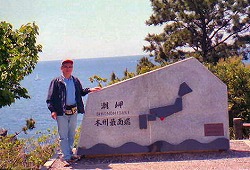 |
|
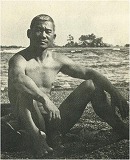 |
| April, 2000 at Cape Shionomisaki |
|
My father, aged 50 |
Long time ago, my father started here from Shionomisaki off south for the
Arafura Sea in the Southern Hemisphere, north of Australia, on a 100-ton
ship as a member of a fleet picking pearls and pearl oysters at the age
of 16. After 17 years, he came back to Kushimoto Port next to Cape Shionomisaki.
My father was different from his son who was brought up protected from
everything and quite naive.
|
| - - - - - - - - - - - |
|
Sintra, May 15
We arrived at Sintra, a town in the mountains, 15 km on the way from Cape
Roca to Lisbon.
This place is known for its many 19th-century Romantic architectural monuments,
which resulted in its classification as a UNESCO World Heritage Site. According
to WIKIPEDIA:
| Although its heritage in buildings and nature is the most visible face
of the historic individuality of Sintra, a whole literary heritage has
made the area a legendary reference in Portuguese culture. It has become
a major tourist centre, visited by many day-trippers who travel from the
centre and suburbs of the capital Lisbon. In addition to the Sintra Mountains
and Sintra-Cascais Nature Park, the parishes of the town of Sintra are
dotted with royal retreats, estates, castles and other buildings, including
the mediaeval Castelo dos Mouros, the Pena National Palace and the Sintra
National Palace. |
Palácio Nacional de Sintra
(Sintra National Palace)

This National Palace is presently a historic house museum.
It is the best preserved medieval Royal Palace in Portugal, being inhabited
more or less continuously from at least the early 15th century to the late
19th century. It is a significant tourist attraction, and is part of the
cultural landscape of Sintra, a designated UNESCO World Heritage Site.
We entered the Royal Palace from the facade of the above picture and looked
around inside for a while.
By the way, the Tensho Embassy from Japan, written at the passage of Evora, visited this palace too. According to WIKIPEDIA, they were granted an audience with Cardinal Austria, entrusted with the rule of Portugal, here in August, 1584.
|
|
| Part 5 Lisbon (1) Reading: 13' 16" |
| - - - - - - - - - - - |
|
Lisbon (2), May 16
All tour members were free until 16:30 on the last sightseeing day.
Our couple enjoyed the 3 plaza districts and the surrounding areas in Baixa,
making use of the subway.
Our hotel Sheraton Lisbon of 5 stars is in the center of the city.
It must be equipped with every luxurious facility with the best atmosphere.
It was my true regret only to stay here for 2 nights.
The next door to the hotel is the subway station Picoas, where we got on
the train to and from Estação Ferroviária do Rossio, in Old Town. The free time gave us a precious experience.
We changed trains twice and got to Rossio Station safely after 40 minutes.
Getting out of Rossio Subway Station, we were in Rossio Plaza, an important
rendevous place of Lisbon citizens (Lisboans). The whole area from this
place to the south is called Baixa District, the busiest downtown in Lisbon.
The streets here are laid out in a grid pattern in a map, convenient.
We went to the south for 30 minutes, and then began a slow walk from Praça
do Comércio.
Not a fine weather in May, but no worry of rain. The temperature was comfortable
just like in Tokyo.
I took a lot of pictures around. The knight on a horse seemed to be Joseph
1 of Portugal.
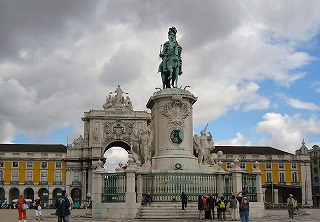
We walked from Praça do Comércio north to Praça da Figueira and Praça de
Rossio on the left, the end of our walking.
Our lunch was a little gorgeous for the memory of this trip. "Marinated
Carpaccio, a white meat fish and the soup called Açorda de Marisco, peculiar
to Portugal.
Taste? Presumptuously second to Emiko's home-made dish to be honest. But
I cried "E muito gostoso!" (Delicious of all!), keeping mum about
my mind.
Really a comfortable town full of exoticism, with streetcars running frequently.
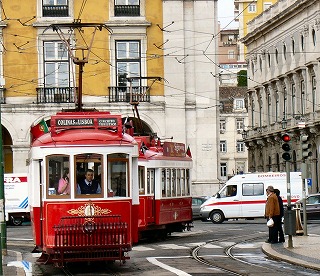
We enjoyed ourselves freely until the assembly time in the evening around Figueira and Rossio Plazas.
Seemingly Lisboans were sitting on a bench and talking pleasantly. There
was something here not felt anywhere in Spain.
These two neighboring countries used to be the same zone of Islamic culture
until the Middle Ages. Spain remains the Islamic culture deeply now since
Reconquista, and on the other hand Portugal changed fully to the Catholic
culture. Spain faces the Mediterranean Sea, while Portugal faces the Atlantic
Ocean.
I admit they are not the only differences between the two countries. But
what others? Races, politics, .....
Repeating the endless selfish dialogue to myself, I was devoted to taking
pictures and Emiko was forced to be a model.
The last supper with the tour members was at the restaurant in the hotel
Sheraton. It was, needless to say, gorgeous dinner with the local wine
of muscat.

|
| - - - - - - - - - - - |
That's all about the ostentatious story of my 10-day trip around Iberian
Peninsula.
Obrigado, Tchau to Portugal, and Gracias, Adios to Spain. Thank you very
much and goodbye to the Iberian Peninsula. |
|
| Part 5 Lisbon (2) Reading: 5' 39" |
| - - - - - - - - - - - |
| Other Pictures in Évora |
|
| Other Pictures in Lisbon |
|
| Other Pictures at Cabo da Roca and Sintra |
|
| Memo |
|
|
|
|
Spain |
|
Portugal |
|
|
|
|
|
Country
Name |
|
Kingdom of Spain
Reino de España |
|
Portuguese Republic
República Portuguesa |
| Government |
|
Unitary Parliamentary
constitutional monarchy |
|
Unitary semi-presidential
constitutional republic |
| Official Language |
|
Spanish |
|
Portuguese |
| Ethnic Groups |
|
Spanish 89.9%
others 10.1% |
|
Portuguese: 96.3%
others: 3.7% |
| Area |
|
505,990 km2 |
|
92,212 km2 |
| Population |
|
46,439,864 (as of 2015) |
|
10,427,301 (as of 2014) |
| Capital |
|
Madrid
(population 3,090,000) |
|
Lisbon
(population: 560,000) |
| Religion |
|
Roman Catholic Church
(predominant) |
|
Roman Catholic Church
(predominant) |
|
|
|